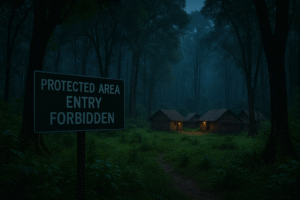Fun fact: Long before humans invented the plough or learned to domesticate wheat and rice, ants were already farming. Yes, you read that right. These tiny insects — often dismissed as picnic raiders or household pests — have been quietly running farms for millions of years. And that’s the question we’ll explore today: How do ants farm?
When we think of agriculture, we usually imagine fields of rice paddies in Bengal, wheat plains in Punjab, or perhaps sprawling industrial farms in America. But underground, in the dark soil beneath our feet, ants are cultivating fungus gardens, herding aphids, and running farming operations with an efficiency that would put many human farmers to shame.
It’s not just science — it’s a story that challenges our assumptions about intelligence, cooperation, and the meaning of “civilization.”
The Oldest Farmers on Earth
Human agriculture is only about 10,000 years old. Ant agriculture? At least 50 million years old. Fossil evidence and genetic studies show that certain ant lineages, particularly leafcutter ants in South and Central America, have been farming fungus since the time dinosaurs disappeared.
These ants don’t just randomly drop leaves into a hole and hope something grows. They have perfected the craft: they collect specific plant material, carefully chew it, inoculate it with fungal spores, and then tend the fungus like a delicate crop. If weeds or unwanted fungi threaten the harvest, worker ants remove them, just as a farmer weeds his field.
Think about it — ants invented pest control, soil management, and even crop specialization before humans knew how to sharpen a stick.
Farming Styles in the Ant World
Ant farming isn’t one-size-fits-all. Different species have developed different methods of agriculture, and each is worth a closer look.
Fungus Farming: The Leafcutter Empire
Leafcutter ants (Atta and Acromyrmex) are perhaps the best-known insect farmers. They cut fresh leaves, carry them back to underground chambers, and use them as compost for cultivating fungus (Leucoagaricus gongylophorus).
The relationship is symbiotic: the fungus cannot survive without the ants, and the ants rely on the fungus as their primary food source. Entire ant colonies — millions strong — exist as agricultural civilizations centered around their fungal crops.
Scientists often compare these colonies to human societies: a division of labor, workers tending the crops, guards defending the colony, and “farmers” ensuring food security. In fact, their underground farms can span several meters, resembling the size of a small human farm plot.
Aphid Herding: The Dairy Farmers of the Insect World
In many parts of the world, ants “farm” aphids, small sap-sucking insects. Here’s how it works: aphids feed on plant sap and secrete a sugary liquid called honeydew. Ants adore honeydew. So, instead of hunting aphids, ants protect them from predators, move them to the best feeding spots, and even stroke them gently with their antennae to encourage them to release honeydew — much like milking a cow.
In return, the aphids provide a steady, renewable food source. It’s agriculture at its simplest — a form of insect dairy farming.
Cultivating Algae and Fungi Beyond Leafcutters
Some ants in tropical Asia and Africa cultivate fungus not with leaves but with insect droppings or dead plant matter. Others have been observed farming algae inside their nests. These smaller-scale farming methods reveal how adaptable ants are: wherever they live, they find a way to grow food.

The Science of Ant Agriculture
What makes ant farming extraordinary isn’t just that it exists, but that it mirrors many human farming principles.
Division of Labor: Some ants cut leaves, others chew, others weed, and some even serve as guards.
Crop Management: Ants selectively cultivate one species of fungus while eliminating competitors.
Soil & Moisture Control: Leafcutters regulate humidity and temperature in their underground farms, opening and closing tunnels to maintain the perfect “greenhouse.”
Pest Control: Certain ants cultivate bacteria on their bodies that act like living pesticides, killing harmful fungi that threaten their crops.
It’s a sophisticated system of biotechnology — without tractors, irrigation, or chemical sprays.
Case Studies and Anecdotes
Amazon Rainforest: The Ant Cities
In the Amazon, scientists have dug into leafcutter nests that span the size of football fields underground. Within these “ant cities,” millions of ants live and labour together in perfect harmony. Their waste management systems recycle organic matter into compost, feeding the fungus. It’s a closed-loop system that mirrors sustainable farming principles humans are only now rediscovering.
Indian Context: Lessons from Ant Farming
While leafcutter ants don’t exist in India, aphid-farming ants are common across the country. Farmers often notice ants clustering on their crops, not realizing these ants are “protecting” aphids the way herders protect cattle. This complicates pest management because pesticides may kill one insect but not the whole ecological system. Understanding ant farming could help Indian farmers design more integrated pest control strategies.
What Ants Can Teach Us About Ourselves
Ant farming poses uncomfortable questions for humans. If ants — with no written language, no universities, no tractors — can sustain farming for 50 million years without collapsing ecosystems, what does that say about us?
Our agriculture is barely 10,000 years old, and already we face soil degradation, pesticide resistance, water scarcity, and climate change. Ants, on the other hand, have maintained stable, resilient farming systems across evolutionary time.
Maybe intelligence isn’t about who builds the biggest machines, but who builds systems that last.
Conclusion
So, how do ants farm? They cut, they herd, they weed, they milk, they compost — all in miniature. Ants are not just survivors; they are innovators, pioneers of agriculture, and silent teachers buried beneath our feet.
If their story teaches us anything, it’s this: sustainability is possible. But it requires humility, balance, and respect for the systems we depend on.
The next time you see a line of ants carrying leaves, pause for a moment. You’re not just looking at insects. You’re looking at one of Earth’s oldest farming civilizations — one that might just outlast ours.
Author’s Note
I wrote this piece because ants remind us that farming is more than profit or production — it’s about survival, balance, and resilience. If insects can teach us about agriculture, maybe it’s time we start listening.
G.C., Ecosociosphere contributor.




